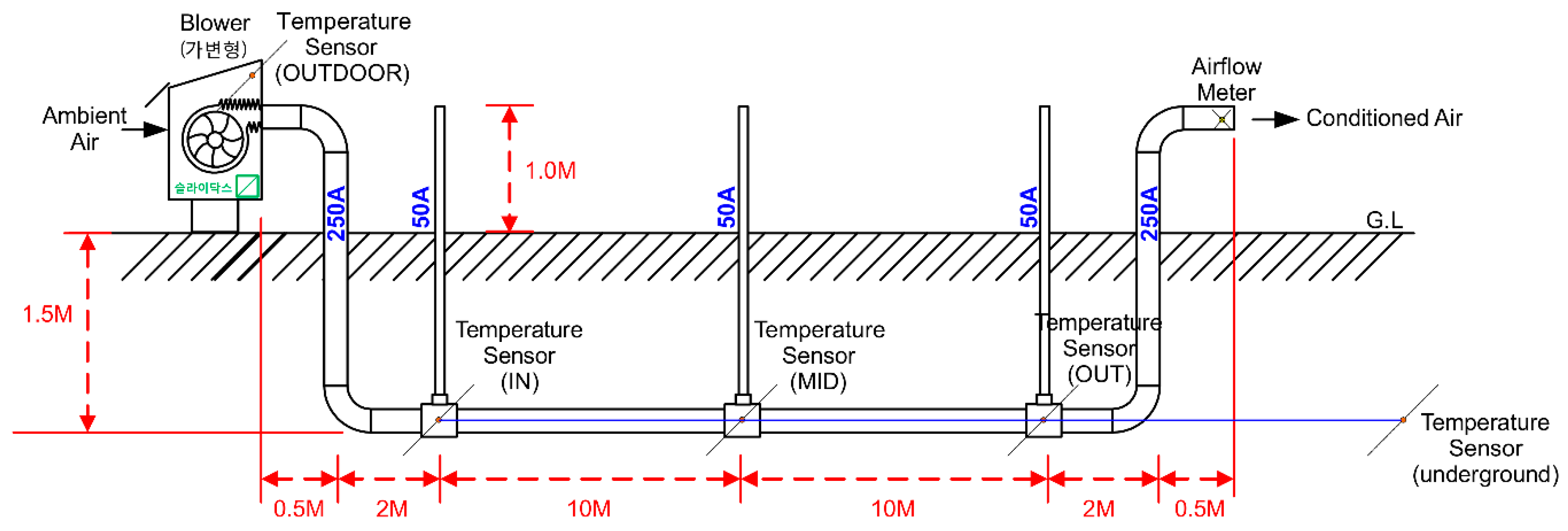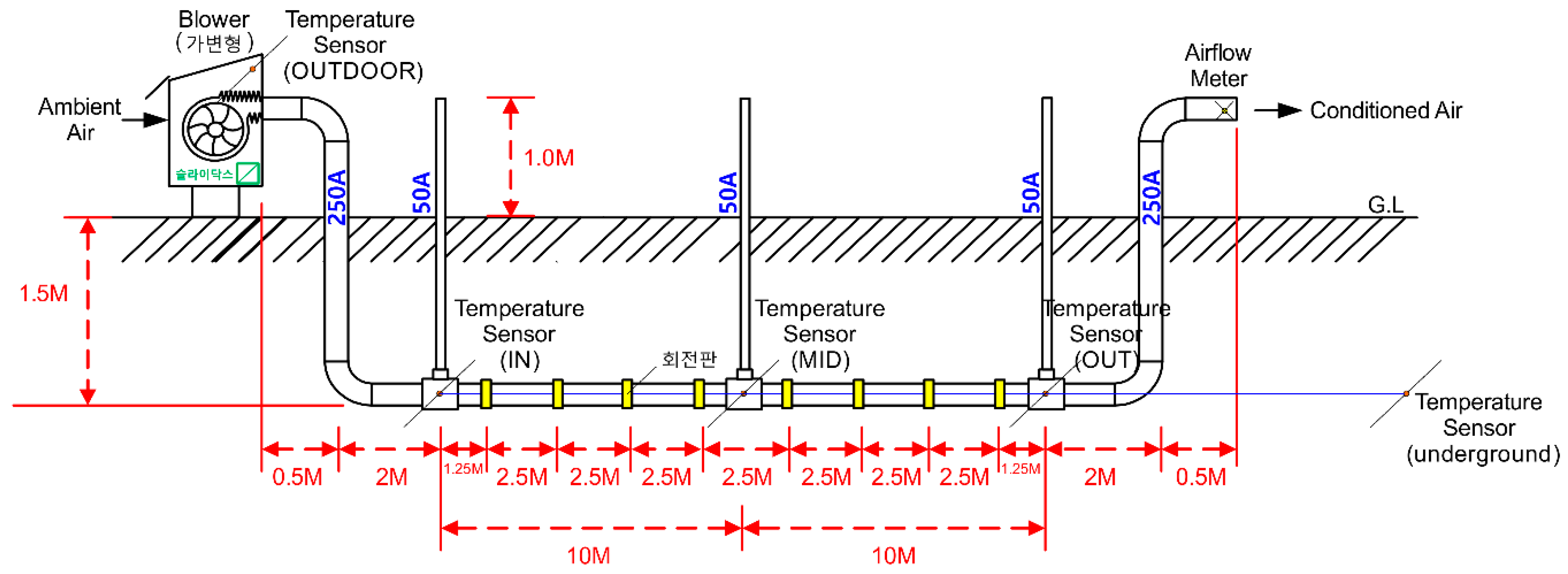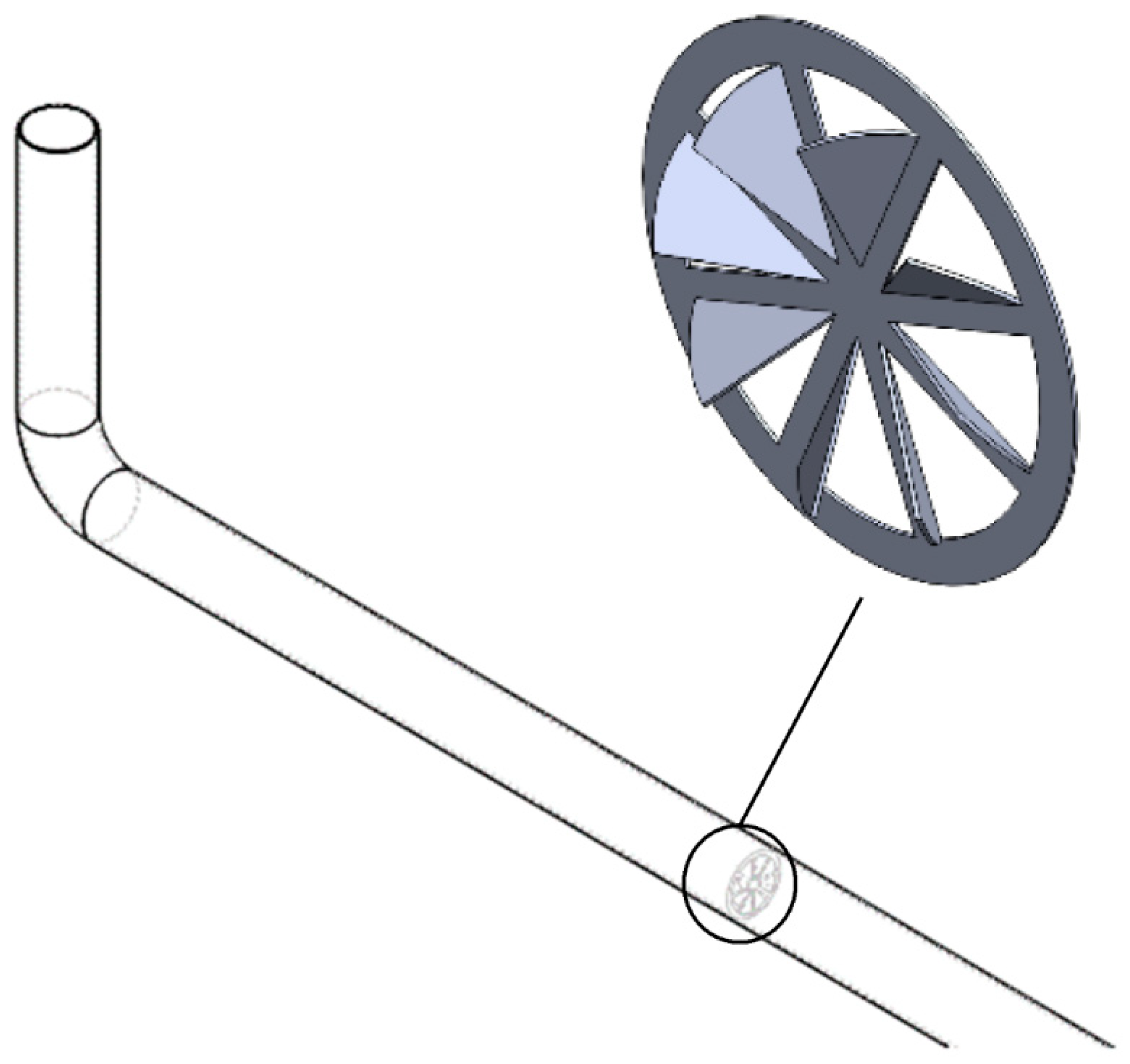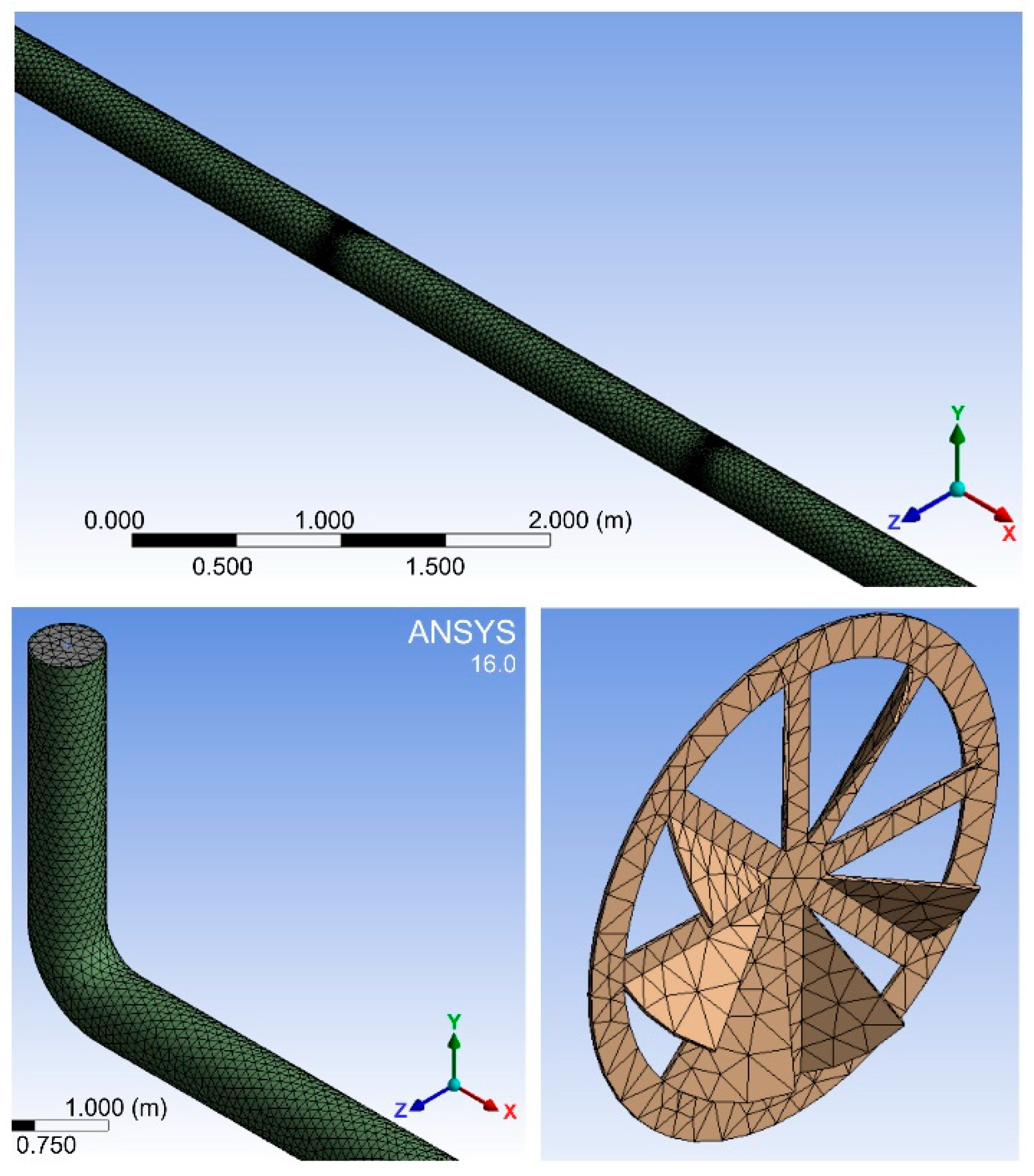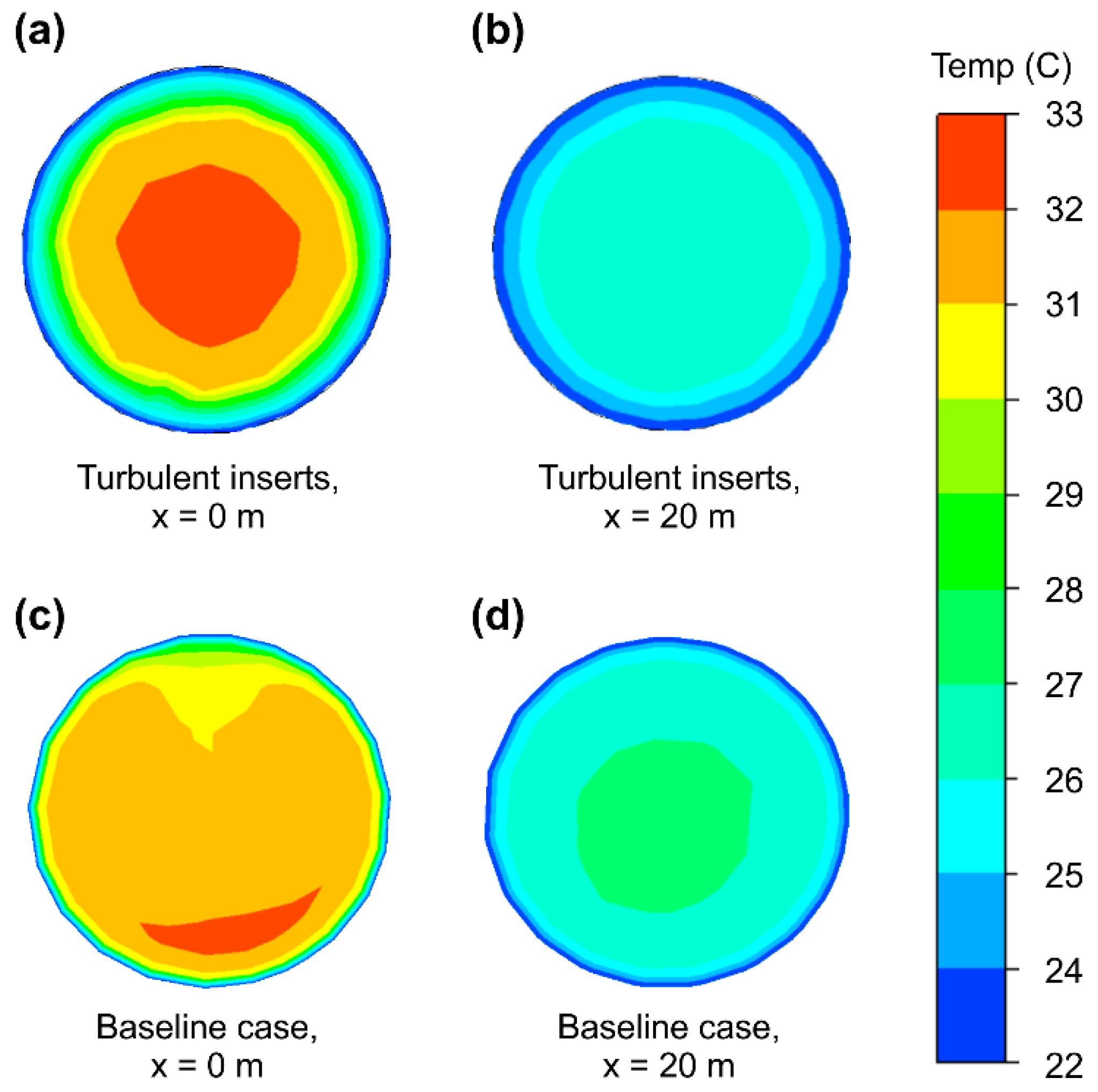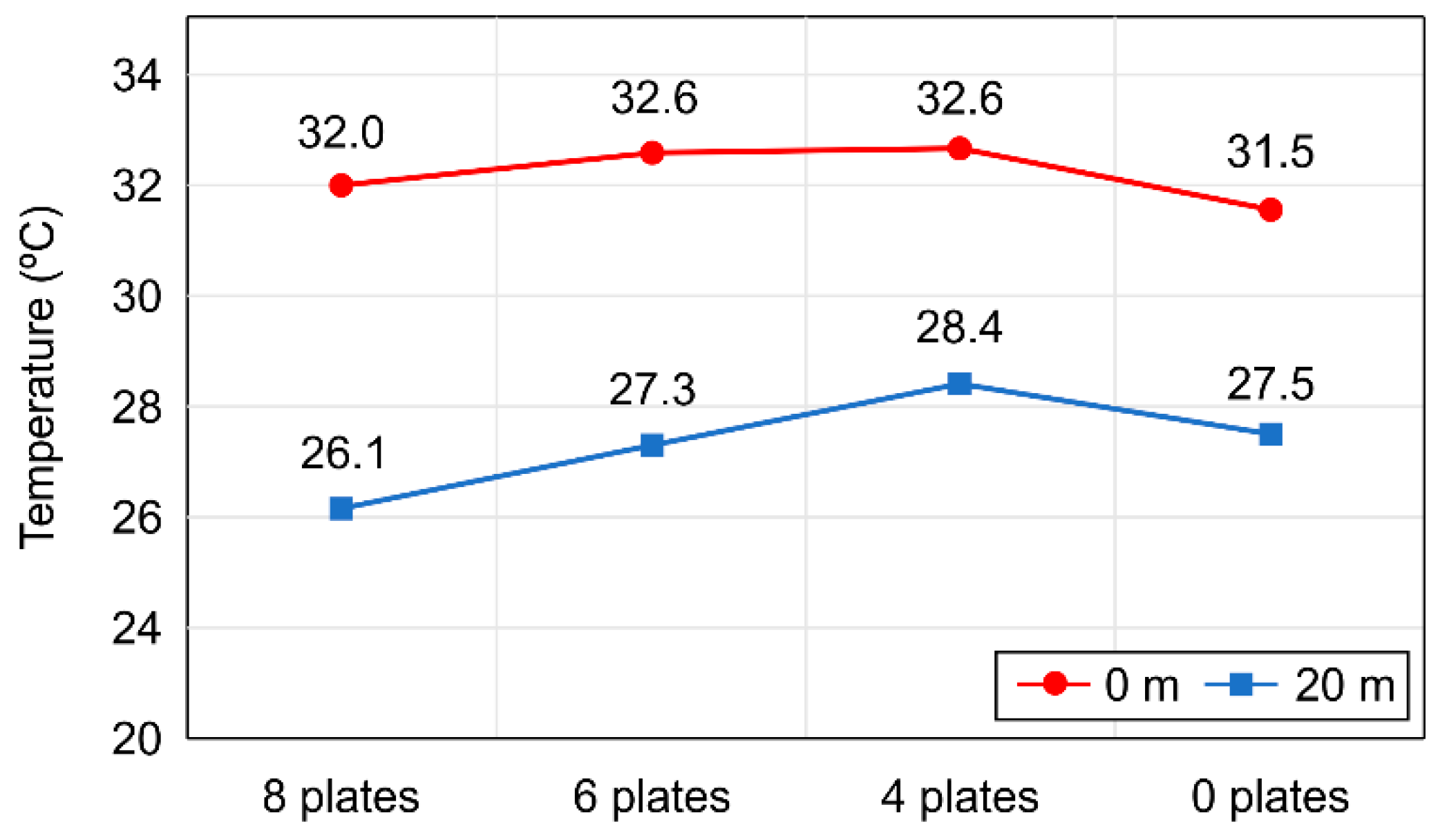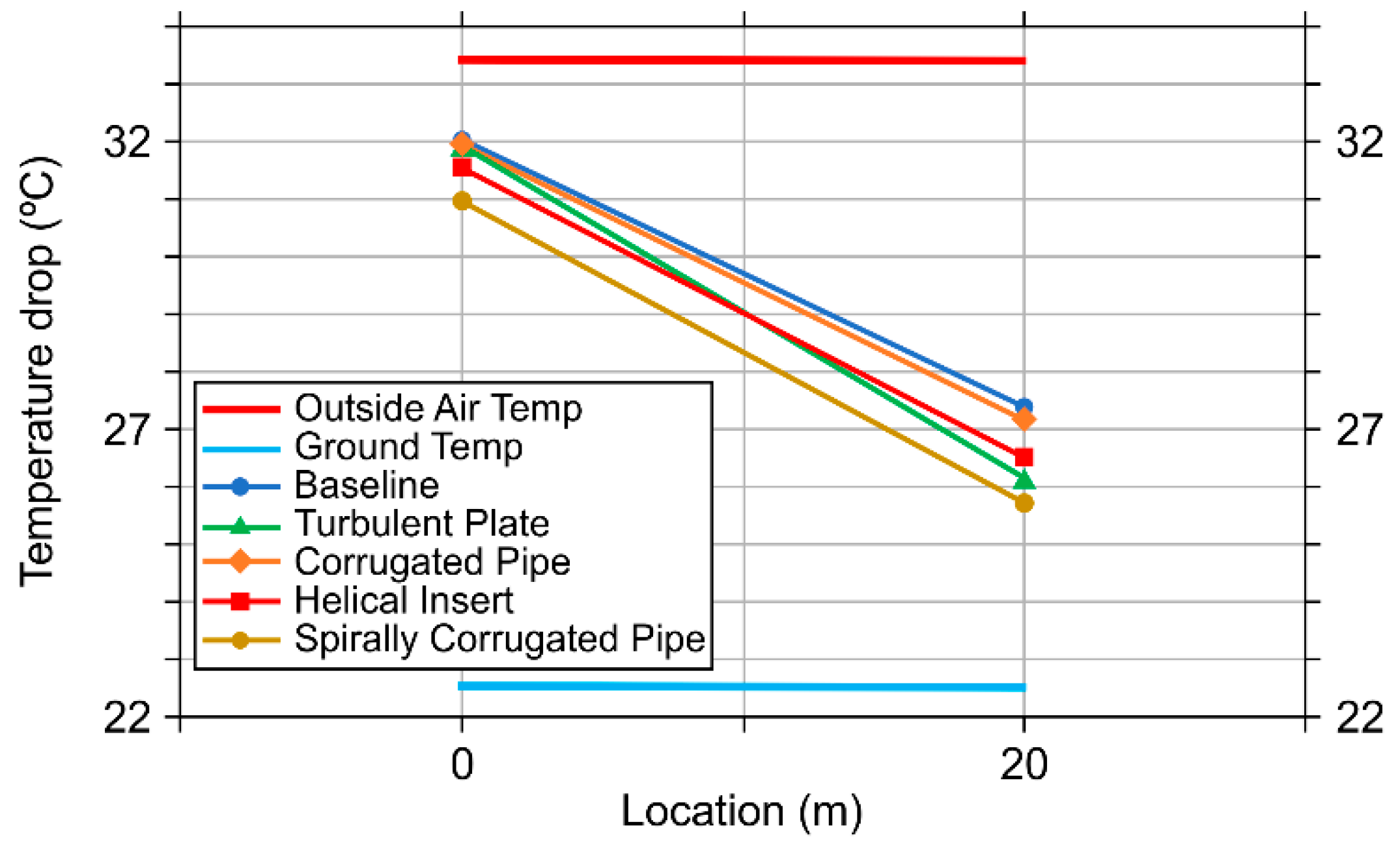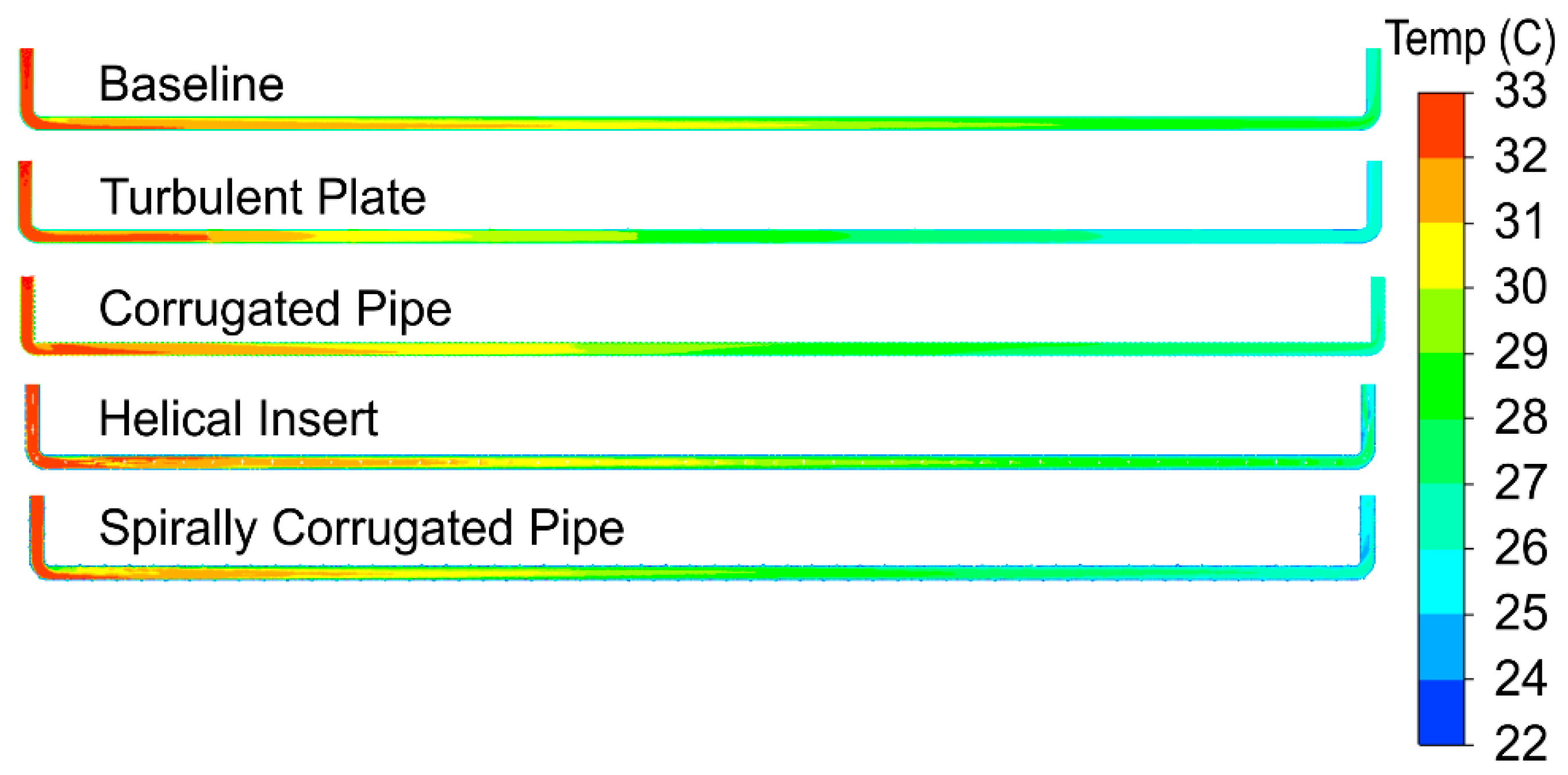1. Introduction
Ground-air heat exchangers (GAHX), commonly known as earth tubes, are underground heat exchangers that can capture or dissipate heat into the ground. At a certain depth, the ground temperature is nearly constant. Therefore, when outside air is moved by a blower through buried pipes, it is conditioned and then used for either partial or full home cooling in summer or heating in winter. Earth tubes are often a viable and economical alternative or supplement to conventional central heating or air-conditioning systems because there are no compressors, chemicals, or burners. In addition, only blowers are required to move the air. This nearly-free cooling technique can meet passive house standards and Leadership in Energy and Environmental Design (LEED) certification.
GAHX have been introduced in the literature during recent years. Yildiz et al. [
1] analyzed a PV assisted closed-loop earth-to-air heat exchanger system, while Lee et al. [
2] introduced a GAHX design for a heat pump system. Muehleisen [
3] developed simple design tools for earth-air heat exchangers, while Hollmuller et al. [
4] and Lee et al. [
5] researched earth tube models using simulations. Vlad et al. [
6] and De Paepe [
7] introduced how to design GAHX. Rehau [
8] produced an eco-air system based on GAHX technology. The Korea Institute of Energy Research [
9] has investigated a trigeneration system with GAHX, while Vikas et al. [
10] conducted GAHX performance analyses. Viorel et al. [
11] developed a simple GAHX model and Huijun et al. [
12] studied an evaluation model.
In recent research, Mroslaw et al. [
13] conducted a comparison study of the thermal performance of GAHX, Cuny et al. [
14] studied GAHX on different soil types, Amanowicz, Ł. [
15] performed GAHX CFD on different pipe paths, however, it did not include pipe shape. Zhao et al. [
16] and Noorollahi et al. [
17] have studied parametric design of GAHX, Agrawal et al. [
18,
19] discussed recent research trends on GAHX and GAHX effect on climate and soil conditions. Mahdavi et al. [
20] evaluated photovoltaic-thermal(PVT)-GAHX system’s potential. Ali et al. [
21] has studied optimization of GAHX, and Li, H [
22] has studied the feasibility of the GAHX system. Following the recent studies survey, GAXH are newly applied and coupled with renewable energy system.
GAHX also play an important role in geothermal technology. Ground source heat pumps rely on earth tubes to transfer heat to or from the ground. GAHX are more energy-efficient than air-source heat pumps because ground temperatures are more stable than air temperatures throughout the year.
The driving force for heat transfer is the difference between the ambient air and ground temperatures. This temperature difference (∆T) changes little throughout a day, and the goal is to maximize ∆T. Optimization efforts must consider maximizing the pipe wall area to enhance convective heat transfer. It also requires pipe length to be long enough to obtain the desired temperature drop or rise in summer or winter, respectively, before reaching the house. However, pipe sizing is constrained to yield a more cost-effective design for users.
The heat transfer rate in GAHX applications is of paramount importance. If one can effectively control the rate at which the heat is transferred to or from the ground, pipe length and manufacturing cost can be reduced. The resistance level to heat flow of air cannot be controlled, but it can be influenced by the design. Specifically, turbulence generation within fluids can prevent the creation of a thermally resistant static “boundary layer” of fluid in contact with the transfer surface. An effective way to reduce this effect is to utilize a spirally corrugated pipe (i.e., deforming a tube with a continuous spiral indentation). Research has shown that by carefully choosing the depth, angle, and width of the indentation, boundary layer resistance can decrease faster than pressure.
Finally, different materials offer a variety of thermal conductivity, which is vital to the conductive heat transfer process to or from the ground via the pipe. This factor is also controlled by the designer along with the pipe boundary shape. The chosen material must be compatible with the process fluids, and it must have a low resistance to heat flow so that it does not become the overriding factor in the conductive heat transfer process.
In this study, GAHX produced the best design for maximum temperature variation and minimum pressure drop. This result showed a good match between the simulation results and the experimental results. Moreover, additional work has been done to explore various design alternatives to improve temperature reduction. As a result, the coefficient of performance (COP) of the AWHP system used in an office space was 3.0, calculated so the 111-m pipe length with a diameter of 250 mm could provide 6 kW of thermal power.
2. Computational Setup
Our simulation experiment consisted of two parts—validation and potential designs. The validation study focused on the two models—baseline and turbulent insert cases. The overall appearance of the baseline case is shown in
Figure 1.
Only the pipe section beneath the ground was included in the computational domain. In other words, the temperatures at the pipe inlet and exit were assumed to be constant and the same at their nearest ground-level boundaries. The turbulent insert case featured the baseline case plus eight turbulent inserts, as shown in
Figure 2.
The total computational pipe length for both cases was 88.6 ft (27 m) and the inner diameter of the pipes was 0.82 ft (0.250 m) with a thickness of 0.0279 ft (0.0085 m). In the turbulent insert pipe, the inserts were circular plates with angularly bent fins (
Figure 3). These plates were placed 8.2 ft (2.5 m) from each other (
Figure 2). There were three temperature sensors placed at 0, 10, and 20 m (
Figure 2 and
Figure 3). However, only positions 0 and 20 m were monitored in the validation study.
The simulation was performed for four consecutive days corresponding to the experimental data observed during summer in South Korea. The ground and outdoor temperatures are reported in
Table 1. The highest and lowest temperature difference between the ground and outdoors was 12.8 and 9.2 °C, respectively.
A commercial simulation platform was used to perform numerical simulations. For the purpose of this study, a standard
k-ε turbulence model with a standard wall function was chosen among the available models (Launder–Spalding wall function, scalable wall functions, non-equilibrium wall functions, enhanced wall treatment, etc.). The model was also chosen due to its stability and simplicity as the turbulent viscosity is calculated in a less complex way. The standard wall function has some weaknesses when applied to complex problems such as high-pressure gradients, buoyancy and complex strains, but in this case, its use is justified as the flow does not experience rapid changes near the pipe inside-walls. For boundary conditions, the velocity inlet and pressure outlet were prescribed at the pipe entrance, respectively. The air entering the pipe was assumed to have an outdoor temperature corresponding to each experimental day (see
Table 1). The turbulent intensity was set at 10% as per Basse, N. T. [
23] and the Reynolds number and the hydraulic diameter at the inlet was set at 0.82 ft (0.250 m). For the solution method, we used the SIMPLE scheme for pressure-velocity coupling with least-squares cells based on standard pressure. A first-order upwind scheme was applied for momentum, turbulent kinetic energy, and turbulent dissipation rate as its application is sufficient when applied to heat-flow applications with no presence of chemical reactions. However, a second-order upwind scheme was used for the pressure and energy equations. Convergence was reached when the residual was less than 10
−6 for all parameters including continuity, energy, velocities, and the
k and
ε equations. Convergence also occurred when the pipe outlet temperature stabilized at a constant value.
4. Design Guideline of a GAHX for an AWHP
In this section, we demonstrate how to select the most optimal pipe design in terms of type, material, and size. From the previous section, the spirally corrugated pipe was determined to be the most desirable. In the following example, a calculation is performed for a typical office space with a total floor area of 147 m
2 (1581 ft
2). It is desirable for an AWHP system to achieve a coefficient of performance (COP) of approximately 3.0. According to Perko et al. [
24], an average-sized space (186–223 m
2) requires a thermal power of 10.6 kW to 11.4 kW, depending on climate conditions. In the worst-case scenario, a small area of 186 m
2 requires a heating power of 11.4 kW. The ratio (r) of floor area per kilowatt can then be calculated as:
where, r is the floor area ratio per kW, A is floor area, and P is the required heating power.
The thermal power at the condenser was then calculated from the actual floor area of 147 m
2 using:
The target COP for the AWHP was set as 3.0. Therefore, the power required from the compressor was:
The required thermal power from air flowing through the buried pipe was therefore calculated as:
In addition, the spirally corrugated pipe had a total length of 28 m. Therefore, heat extraction from the ground source was calculated as:
The target COP 3.0 resulted in a required thermal power from the underground pipe of 6 kW. From here, the total pipe length was calculated using:
Finally, the actual pipe length including the U-shape section to the ground surface was calculated by adding an extra 8 m:
The final optimal pipe design is summarized in
Table 7. This design yielded a maximum 6 kW in thermal power on top of the 3-kW power required by the compressor. This allowed a COP of 3.0 for the AWHP system used to heat up an office space of 147 m
2 (1581 ft
2) in winter.
